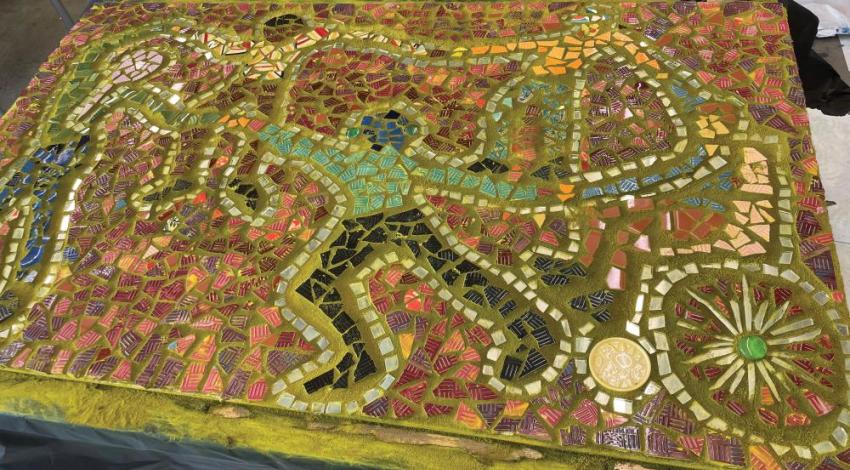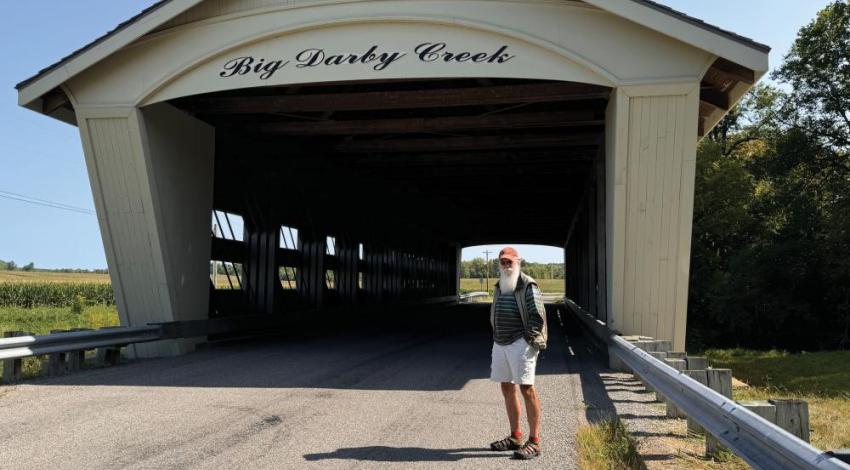Co-op member and barn artist Scott Hagan (Photo by Damaine Vonada)
When Scott Hagan remodeled his home, he and his wife, Amanda, picked reclaimed barn wood for the staircase and fireplace mantle. It was an obvious choice, given Hagan’s history.
Hagan, a South Central Power Company member from Jerusalem, Ohio, is the artist who painted the Bicentennial Barns for Ohio’s 200th birthday celebration of 2003. As far as he knows, he’s still the only professional barn artist around — and his portfolio has grown to include not only the 88 Bicentennial Barns, but more than 800 additional barns, silos, and other structures across the country (check out www.barnartist.com to see most of them).
Hagan resides with his wife and their two daughters on the family cattle farm in Belmont County in a house that once belonged to his great-grandmother, just down
the road from his parents, Rick and Linda Hagan. While Hagan says he inherited his artistic talent from his mother, he grew up doing farm chores with his father. “During winter,” says Hagan, “Dad still calls me in the middle of the night to help him pull a calf.”
Hagan’s career as a barn artist began on a whim in 1997, when he painted Ohio State’s Block O logo and Brutus Buckeye mascot on his father’s barn. “I was 19,” recalls Hagan, “and just wanted something big to paint.” A newspaper in Barnesville featured Hagan’s supersized art in a front-page story that caught the eye of the Ohio Bicentennial Commission.
At the time, the commission was looking to build excitement for the state’s bicentennial, and after meeting with Hagan, then-Director Stephen George hired him to paint the “1803–2003” logo on barns in each of Ohio’s 88 counties. “The Bicentennial Barns were like giving everybody their own slice of birthday cake,” says George, now senior adviser to Ohio History Connection’s CEO.
According to George, Hagan’s “salt of the earth” personality and farming background made him ideal for the project. “For a 19-year-old, Scott had a real understanding of the job’s significance,” George says, “and he had no trouble walking through a pasture to get to a barn. He was very confident in a rural environment.” According to the Ohio Bicentennial Commission’s final report, he traveled in the neighborhood of 65,000 miles and used 650 gallons of pain in the effort.
To Hagan’s surprise, the Bicentennial Barns brought him a certain celebrity. People showed up with picnic baskets to watch him work, asked for autographs, and even applauded when he finished painting a barn. “Scott is such a nice guy that people grew to love him,” George says. “He became like a folk hero.”
“I never intended to make barn art a career when I started, but 21 years later, I’m still doing it and I still like it.”
After Hagan completed Ohio’s Bicentennial Barns, he got dozens — hundreds — of requests to decorate more farm structures. While his barn art depicts everything from corn to quilt squares, he especially enjoys doing American flags, and in fact, when Hagan repainted his dad’s barn, he changed his original Ohio State symbols to Old Glory and an eagle.
In 2015, Hagan began painting Ohio History Barns, commissioned by the Ohio History Connection and local historical societies, to present Ohio’s rich heritage of significant people, places, and achievements, and to whet the public’s appetite to learn more.
“I never intended to make barn art a career when I started,” Hagan says, “but 21 years later, I’m still doing it and I still like it.”









